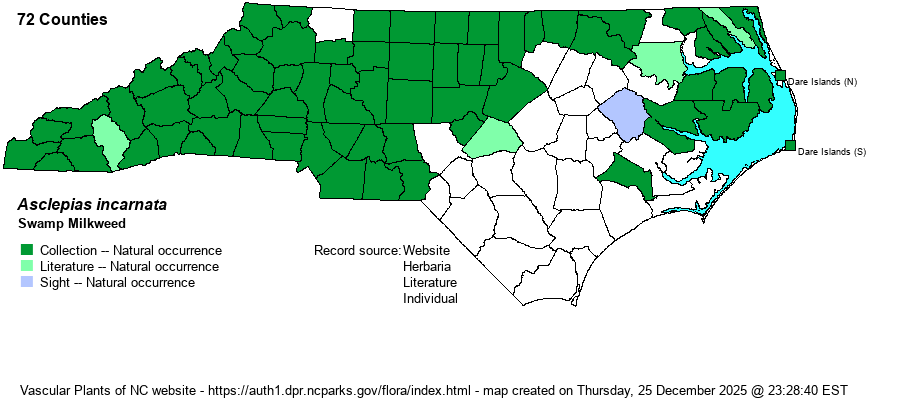| Author | L. | |
| Distribution | Throughout the Mountains and Piedmont; in the Coastal Plain occurs mainly in the northeastern quarter, being scarce to absent in the southern half of the province and surprisingly scarce in the northwestern Coastal Plain. Apparently absent in the Sandhills region.
This species is a very widespread eastern species, ranging from Canada south to FL and NM. | |
| Abundance | Frequent to common across the Mountains and Piedmont; also frequent to common in the northeastern Coastal Plain south to Beaufort County. Rare to uncommon in the interior portions of the northern Coastal Plain, south to Pitt and Jones counties. Clearly absent from the southern parts of the Coastal Plain. | |
| Habitat | This is the primary milkweed species found in freshwater marshes in NC. It is normally found in full sun in wetlands, favoring marshes, but it also occurs in mountain bogs, very wet meadows, and openings in swamps and wet spots in bottomlands. The common name is a misnomer -- it is a marsh species, not a swamp species! |
| Phenology | Blooms from July to September, and fruits from August to October. | |
| Identification | This is a fairly tall milkweed, growing to 3-4 feet high, with a few branches in the upper portions. It has numerous paired, opposite leaves, each somewhat lanceolate or narrowly ovate, and about 4-5 inches long and much narrower. This species has quite a few clusters (umbels) of flowers from branch ends or upper leaf axils, and though each cluster is fairly small (about 1.5 inches across), the flowers are bright rose-pink in color and thus create quite a showy plant when in full bloom. It might be a somewhat tricky species to identify for some biologists when not in bloom, but all milkweeds have milky sap, and thus breaking off a branch or a leaf at its base and seeing the white sap should clinch the identification. These plants are easily spotted at a distance of 100 yards or more when in bloom in a marsh, as there are few other rose-colored flower clusters that appear in a freshwater marsh, wet meadow, or bog in midsummer. Not only do botanists enjoy seeing this plant in bloom, butterfliers eagerly seek out flowering Swamp Milkweeds, as they are favored nectar sites for a great variety of insects. | |
| Taxonomic Comments | This species has several varieties over its large range. The more Eastern one, A. incarnata var. pulchra, is the only one known in the state. The nominate one -- var. incarnata -- occurs east to TN and is to be looked for in the NC Mountains in high pH soils. In general, var. pulchra is quite hairy on various parts, as opposed to a smoother plant in the nominate variety.
| |
| Other Common Name(s) | Rose Milkweed | |
| State Rank | S5 | |
| Global Rank | G5 | |
| State Status | | |
| US Status | | |
| USACE-agcp | OBL link |
| USACE-emp | OBL link |

